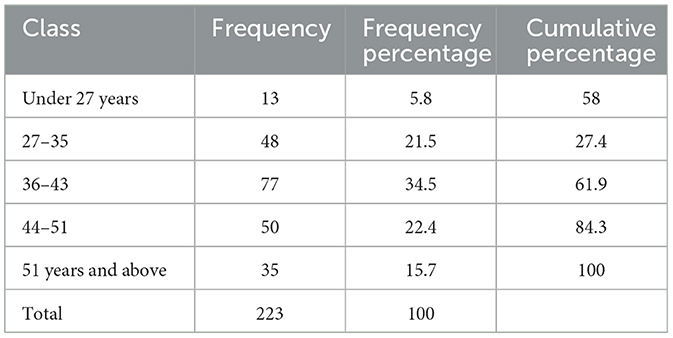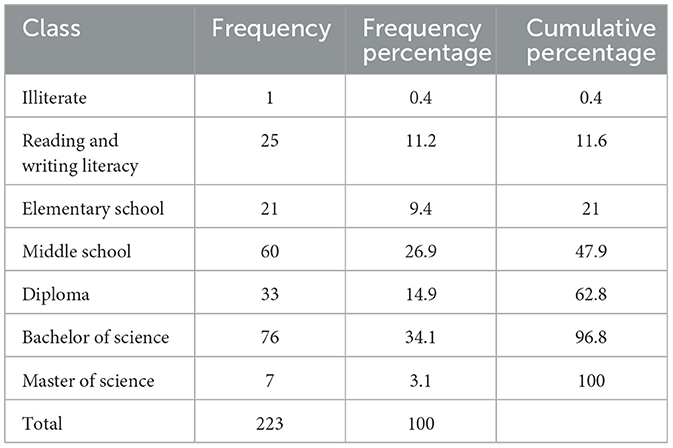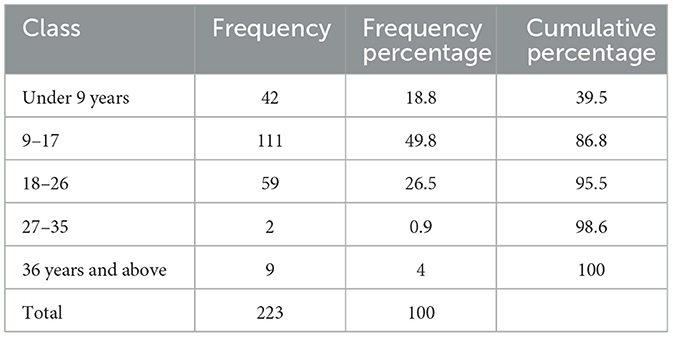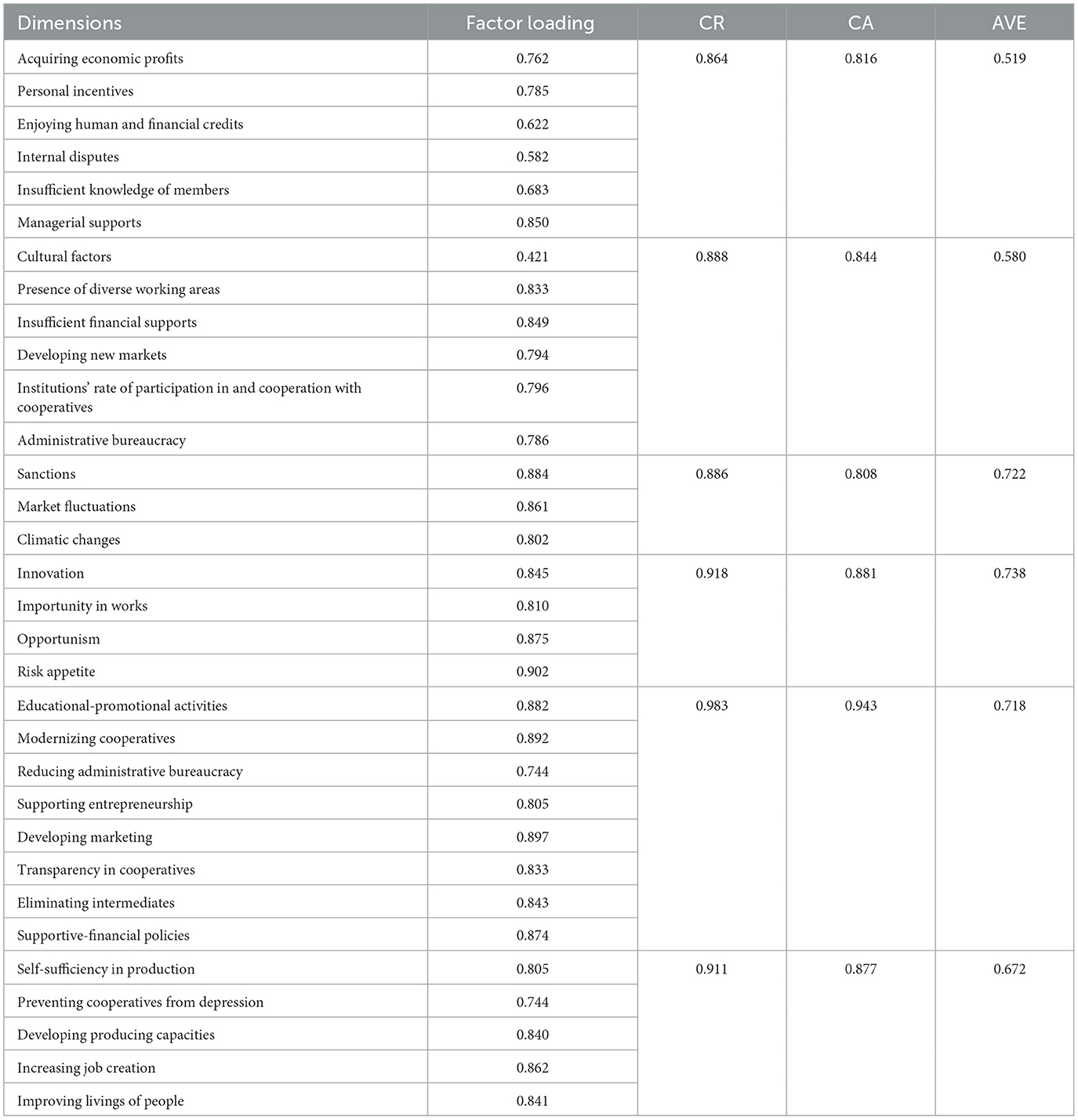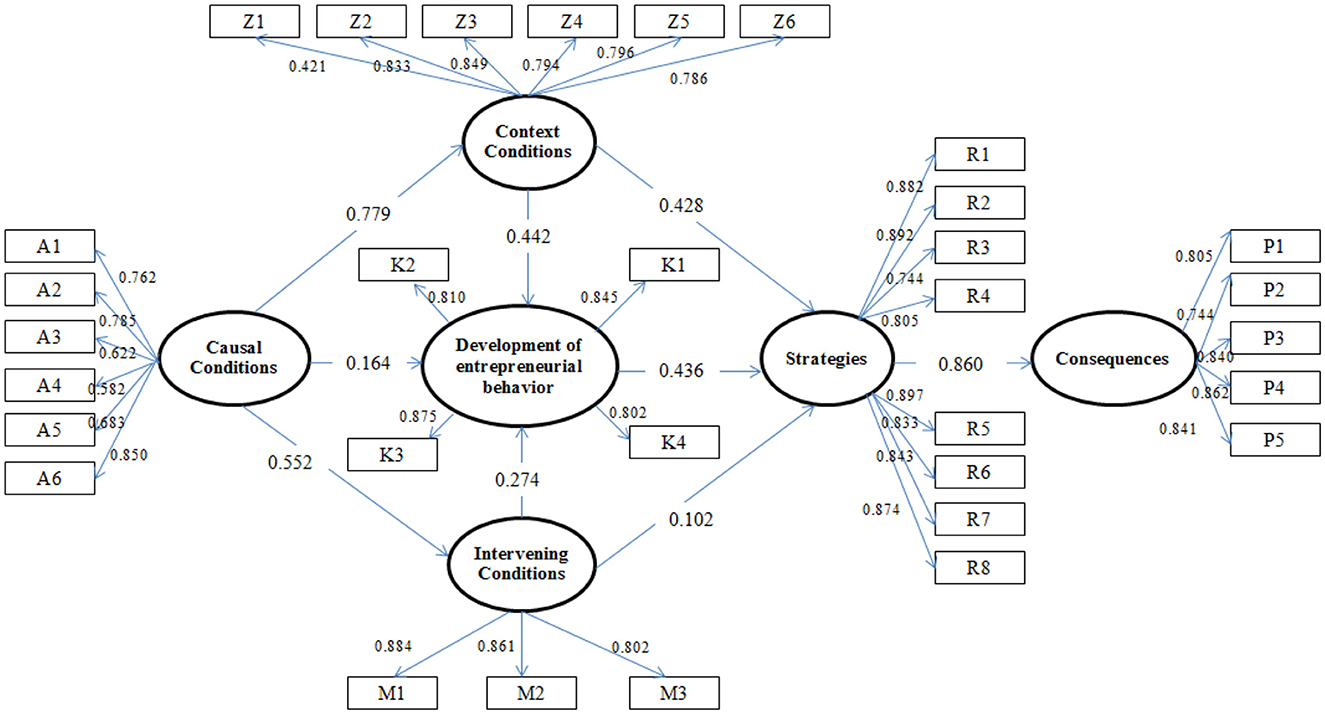- 1Department of Agricultural Extension and Education, Birjand Branch, Islamic Azad University, Birjand, Iran
- 2Department of Management and Entrepreneurship, Faculty of Social Sciences, Economics and Accounting, Razi University, Kermanshah, Iran
Introduction: One of the main problems of agricultural cooperatives in Kermanshah province is the weakness in developing entrepreneurial behaviors. If these entrepreneurial behaviors are developed in agricultural cooperatives, it can be expected that their innovative products and services will be developed and expanded, and the field of improving food security and advancing rural and agricultural development programs in Kermanshah province will be provided. So, the present study aimed to design an entrepreneurial behavior development model in agricultural cooperatives in Kermanshah province using an exploratory mixed-method approach.
Methods: In the qualitative part of the study, the participating team included all key informed individuals in the entrepreneurship area in the cooperatives of Kermanshah province. Thirty participants were selected by snowball purposive sampling. The statistical population of the quantitative phase involved 530 managers and members of the active agricultural cooperatives in Kermanshah province. Among them, 223 were selected by the stratified sampling method and the use of Krejcie and Morgan's table. The data collected in the qualitative phase were analyzed by the Nvivo8 software, and the grounded theory was developed in the form of a conceptual model. In the model analysis, the research hypotheses were first compiled and then analyzed by the path analysis method in SPSS 23 and SmartPLS3 software.
Results: The results of the quantitative phase showed that the causal conditions impacting entrepreneurial behavior development in agricultural cooperatives encompassed the acquisition of economic profits, personal incentives, enjoyment of human and financial credits, internal disputes, insufficient knowledge of the members, and managerial supports. The intervening factors consisted of sanctions, market fluctuations, and climatic changes, and contextual factors comprised cultural factors, diverse working areas, insufficient financial supports, the development of new markets, the institutions' rate of participation in and cooperation with cooperatives, and administrative bureaucracy. Likewise, the proposed strategies embraced promotional-educational practices, the constant modernization of cooperatives, reduction in administrative bureaucracy, supporting entrepreneurship, developing marketing, transparency in the cooperative, eliminating the intermediates, and supportive-financial policies, all of which gave rise to some consequences such as self-sufficiency in production, prevention from cooperative's depression, the development of producing capacities, an increase in job creation, and improvement in the livings of people. The mentioned model was also evaluated in the quantitative section and subsequently approved.
Discussion: Based on the results, it can be said that for the development of entrepreneurial behaviors in agricultural cooperatives, a set of factors must be considered in interaction with each other. Based on the results, it is recommended to increase the information and awareness of cooperative members in the field of improving entrepreneurial behavior.
1 Introduction
Today, the role of agricultural cooperatives' development, as an instrument for the attainment of sustainable rural development, is uncovered to everyone (Giagnocavo et al., 2017; Liu et al., 2019). It is because cooperatives, in step with governmental policies, improve the working, living, producing, and service-providing conditions, enhance the income level and social status of villagers and pave the way for the promotion of the livelihood of farmer families in the face of constraints and problems (XiangyuGuo, 2010; Herbel et al., 2015). Thus, in light of this issue, the pundits and specialists of the rural development domain conclude that although the pastoral sustainable development process depends on diverse and varying factors, conditions, and features, the development of agricultural cooperatives is the most significant factor in rural areas (Kurniawan et al., 2024; Utomo et al., 2023; Khosravi et al., 2016). Hence, as global experiences also confirm this issue, agricultural cooperative companies and organizations in rural areas, especially in developing countries, can have a crucial part in confronting poverty, creating jobs, and developing villages (Ma et al., 2018).
Iran is an example of a developing country in which fighting against poverty and creating jobs are of particular importance (Savari et al., 2024a,b; Savari and Khaleghi, 2023; Shokati Amghani et al., 2023). In this respect, the presence of agricultural cooperatives can be helpful; however, diverse evidence and statistics indicate that Iranian agricultural cooperatives could not reach their actual positions in economic and social arenas (Khosravi et al., 2016). For example, according to the report by the Ministry of Cooperatives, the total number of agricultural and forestry cooperatives registered in the country by late 2015 was 50,511. Among them, 17,217 were active, 7,425 were being initiated, and 25,869 were inactive for different reasons, such as non-profitability after establishment. Similarly, in Kermanshah province, there were 1,478 agricultural cooperatives until late 2015. Among these cooperatives, 679 were active, 174 were being initiated, and 625 were inactive (General Directorate of Cooperatives, Labor, and Social Welfare of Kermanshah Province, 2016). Many inactive cooperatives denote that they could not remain profitable and stable in the competitive market (Khosravi et al., 2016). The different research experiences and inspections have also revealed that many cooperatives were incapable of competing with large and private firms and thus became inactive and dormant (Shojaei et al., 2011). In other words, the agricultural and rural cooperative companies can only help sustainable and constant job creation and development only when they possess entrepreneurial missions, goals, and natures. It is because various studies depict the positive and significant effect of entrepreneurial development on sustainability, profitability, growth, and the efficiency of different firms and institutions (Habbershon and Pistrui, 2002; Zahra et al., 2004; Zahra, 2005; Kellermanns et al., 2008). Global Entrepreneurship Monitoring Office defines entrepreneurship as “any attempt at new business or new venture creation, such as self-employment, a new business organization, or the expansion of an existing business by an individual, a team of individuals, or an established business” (annual report of GEM 2015/2016-Global Report, 2015). Entrepreneurship is the process of identifying opportunities according to marketing needs and supplying for the removal of market needs by taking into account probable risks. From the Office's perspective, an entrepreneur requires a viewpoint to discover opportunities and the ability to invest on them (Hatton, 2015). Entrepreneurship can be generally recognized as a dynamic process that calls for the exploitation of individuals' force and motivation toward creating and implementing new ideas besides applied solutions (Kuratko and Hodgetts, 2007). Therefore, we can state that entrepreneurial development enables companies to not only exploit their competitive advantage but also identify new opportunities and flourish novel competencies in themselves (Kuratko et al., 2005). Thus, corporates should cater for some conditions wherein they can provide the emergence and development of entrepreneurial behavior (Bird and Schjoedt, 2017). Entrepreneurial behavior is defined as all steps and practices of individuals toward discovering, evaluating, and exploiting existing innovative opportunities in the pursuit of entrepreneurial activities (Autio et al., 2014). In the meantime, focusing on entrepreneurial behavior development in agricultural cooperatives is of utmost importance since entrepreneurship results from the emergence of entrepreneurial behavior in individuals (Shapero, 1984). Accordingly, from the viewpoints of Knudson et al. (2004), the development of innovative services, products, and businesses in agriculture, besides the growing process of innovation in the services and products of this sector, necessitates the development and promotion of entrepreneurial behavior in agricultural cooperatives. Thus, since entrepreneurial development in agricultural cooperatives deeply associates with entrepreneurial behavior, on the one hand, and agricultural cooperatives play a vital role in the sustainable rural and agricultural development, on the other hand, we should highlight the necessity of paying attention to entrepreneurial behavior development, as one of the main pillars and components of entrepreneurial development, in agricultural cooperatives. Therefore, concerning the mentioned cases, the present study aimed to design a model for entrepreneurial behavior development in the agricultural cooperatives of Kermanshah province.
Relevant studies have been conducted on the understudied topic. Löffel and Gmür (2024) stated that the development of entrepreneurial behaviors has a positive and significant effect on the economic performance of cooperatives. Kustepeli et al. (2023) showed that the improvement of social capital affects the development of entrepreneurial behaviors in agricultural cooperatives. Bouichou et al. (2021) showed that the risks of agribusiness and financing constraints have a negative influence on entrepreneurial intentions of the youth and women in agricultural cooperatives. Guzmán et al. (2020) stated that the development of entrepreneurship in agricultural cooperatives improves their performance. Lawrence and Ganguli (2016), in a study, investigated the entrepreneurial behavior of stockmen in India. Their results displayed that entrepreneurial behavior positively and significantly correlated with educational factors, land ownership, economic status, social participation, economic motives, and communications. In his study, Mattihalli (2015) showed that occupational experiences, social participation, and participation in promotional programs were among the factors that impacted farmers' entrepreneurial behavior. Dam et al. (2010) demonstrated that the variables of entrepreneurial knowledge, job adjustment, creative thought, networking skills, team-working skills, and entrepreneurial atmosphere had a positive and significant effect on teachers' entrepreneurial behavior. Lawrence and Ganguli (2016), in their course of study, deduced that acquiring economic profits and personal incentives, along with human and financial credits and managerial supports, were the factors that influenced the success in the entrepreneurial behavior. Similarly, Kotlar and Sieger (2018), Michaelis et al. (2019), and Kang et al. (2016) emphasized the effect of economic profits on the development of entrepreneurship behavior.
Based on the reviewed studies and in line with the contribution of the present study, it can be said that few studies such as Lawrence and Ganguli (2016) have directly investigated entrepreneurial behavior and other studies such as Löffel and Gmür (2024), Kustepeli et al. (2023), Bouichou et al. (2021), Guzmán et al. (2020), Mattihalli (2015), Dam et al. (2010), Lawrence and Ganguli (2016), Kotlar and Sieger (2018), Michaelis et al. (2019), and Kang et al. (2016) have only investigated and expressed some of the factors affecting their entrepreneurial behavior in different societies (farmers, teachers, etc.). Therefore, conducting this research has value from the point of view that none of the reviewed studies have been conducted to provide a local model for improving entrepreneurial behaviors among agricultural cooperatives in Kermanshah province, even by using both qualitative and quantitative methods at the same time. Presenting the local model with the grounded theory method (more details in the methodology section) will provide the context to examine the factors affecting the improvement of entrepreneurial behaviors (causal conditions, Contextual conditions and intervening conditions) from the perspective of experts in Kermanshah province. Also, each and every action taken (strategies) and their consequences should also be examined in order to provide practical suggestions for improving entrepreneurial behavior among agricultural cooperatives in Kermanshah province. Therefore, with regard to the mentioned cases, this field study applied a mixed-method approach to introduce a model for entrepreneurship behavior development in the agricultural cooperatives of Kermanshah province.
2 Methodology
The present study is limited to Kermanshah province in terms of location. The capital of Kermanshah province is the city of Kermanshah. This province has an area of 24,549 km2. Kermanshah province is one of the provinces located in the west of Iran. Kermanshah province with an area of 24,640 km2 is ranked 17th among 31 provinces of Iran in terms of size and occupies 1.5% of the total area of Iran. Kermanshah province has more than 330 km of border with Iraq, this province is limited to Kurdistan province from the north, Lorestan and Ilam provinces from the south, Hamedan province from the east and Iraq from the west (Khosravi et al., 2021).
The current research was philosophically founded upon pragmatism and realism schools, as well as participation and collective wisdom. This exploratory-sequential study was applied in terms of its purpose and followed a mixed-method (qualitative-quantitative) approach paradigmatically. The qualitative part employed Straussain grounded Theory (SGT), and the quantitative part utilized structural equation modeling for model testing. In the qualitative phase of the study, employing purposive snowball sampling based on managerial and entrepreneurial expert knowledge in agricultural cooperatives and using semi-structured interviews, the researcher could identify and select 30 experts to participate in the study. In addition to structured interviews, observation, focus group, and field note-taking methods were employed for data collection. The data collection process lasted until attaining theoretical saturation when no new data were obtained, and no new concepts were identified. The questions that were raised in the qualitative phase of the research were in accordance with the grounded theory format (Figure 1) as follows: In your opinion, what are the causal conditions affecting the development of entrepreneurial behaviors in agricultural cooperatives? In your opinion, what are the contextual conditions effective on the development of entrepreneurial behaviors in agricultural cooperatives? In your opinion, what are the intervening conditions effective on the development of entrepreneurial behaviors in agricultural cooperatives? In your opinion, what actions (strategies) have been done so far to develop entrepreneurial behaviors in agricultural cooperatives? What are the consequences of each of these actions? The data collection (interview) approach is conducted face to face. The data analysis followed the phasic method and analytic techniques of Strauss and Corbin in grounded theory, including open, axial, and selective coding. Based on the systematic approach, theorizing is accomplished in three steps: open coding, axial coding, and selective coding. In the stage of selective coding based on the format of Strauss and Corbin (1998), a local model is presented, and the relationships between the variables in the model can be seen in Figure 1 (Mohammadifar et al., 2022; Naderi et al., 2020; Strauss and Corbin, 1998).
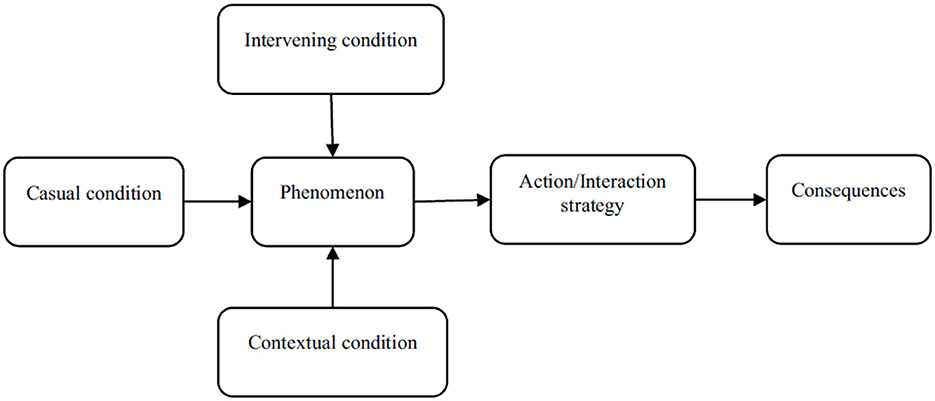
Figure 1. Paradigm model of Strauss and Corbin (1998).
To examine the validity of research findings in the qualitative phase, the researcher exploited the triangulation and member check techniques.
In the quantitative part of the study, 530 managers and members of the active agricultural cooperatives in Kermanshah province were selected as the statistical population. With the help of Krejecie and Morgan's table, the statistical sample was estimated at 223 (Table 1).
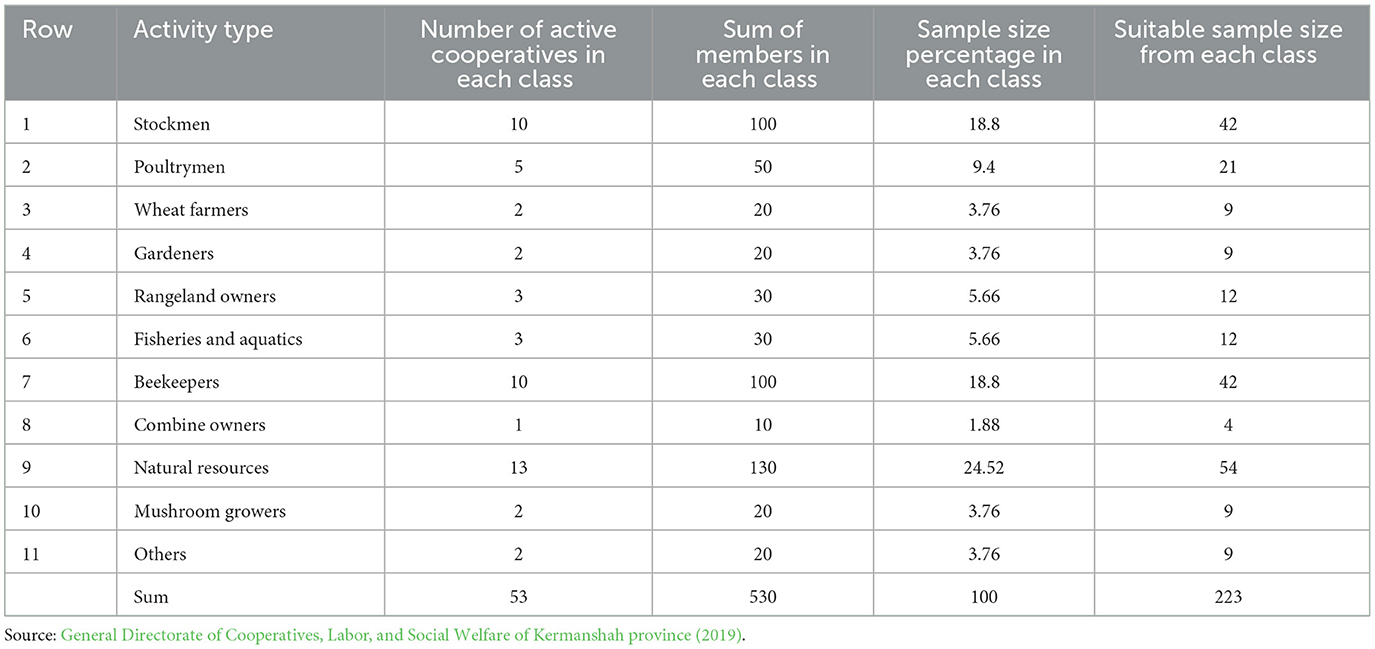
Table 1. Total statistics of active agricultural cooperatives in Kermanshah province, separated by types of activities and number of members.
In this phase, the sample size is stated according to Table 1. According to Kermanshah Province General Directorate of Cooperative Statistics (2023), the size of the population is equal to 530 people who were in 11 types of cooperatives. Therefore, 223 samples were selected using proportional stratified sampling method (Table 1).
Then, the researcher-made questionnaire was distributed among the samples. The questionnaire consisted of two parts, the first part of demographic characteristics and the second part of concepts that were asked using a Likert scale. In the second phase of the research (quantitative part) in order to evaluate the model created in the qualitative part, a questionnaire was designed based on the model of the qualitative part (Figure 1). The questions in the questionnaires were designed based on each concept identified in the qualitative section. The data collection approach is conducted face to face. Lastly, the collected data were the base of analysis in the SPSS 23 and SmartPLS3 software. Thirty experts examined and confirmed the face and conceptual validity of the questionnaire in this section. Afterward, the CVRs of all indices were estimated at 0.7 and thus confirmed. For model fitness, the indices of the factor loading, composite reliability (CR), Cronbach alpha (CA), average variance extracted (AVE), determination coefficient (R2), and goodness of fit (GOF) were employed.
The results of fit indices of the structural model of study show that the values of factor loading (>0.4), AVE (>0.5), and CR and CA (>0.7) are suitable for all constructs. Furthermore, the GOF was calculated at 0.637. Thus, Based on the criteria proposed by Mirakzadeh et al. (2021), we can argue that the structural model enjoys a proper fit. Accordingly, it is illuminated that the selected indices with the factorial infrastructure of the research design enjoy the necessary fitness.
3 Results
3.1 Demographic characteristics
The results of the study showed that the average age of cooperative members is 41.90 years with a standard deviation of 9.93 years, and the age of the youngest respondent is 19 years and the oldest respondent is 60 years. Meanwhile, during a reclassification, the respondents were divided into five age groups (under 27 years, 27–35, 36–43, 44–51, and 51 years and above; Table 2).
Based on the data in Table 2, it can be seen that the highest frequency is related to the third class with 34.5% (77 people frequency) and the lowest frequency is related to the first class with 5.8% (13 people frequency).
The results of the research showed that the appearance and fashion of the gender of the respondents is male, out of 223 samples examined, 177 cases were male (79.4%) and 46 cases were female (20.6%). The results of the study showed that 179 respondents were married (80.3%) and 44 were single (19.7%).
The results regarding the level of education showed that the largest number of respondents have diploma and sub-diploma literacy with 62.8% (with a frequency of 140 people) and 37.2% (with a frequency of 83 people) have bachelor's and higher education (Table 3).
Also, regarding the experience of working in a cooperative, the results indicated that 49.8% of people had 9–17 years of experience (the highest amount of experience) and the lowest amount of experience was related to 36 years and above with a frequency of 4% (Table 4).
3.2 Results of the qualitative section
The entrepreneurial behavior development model developed by grounded theory in the agricultural cooperatives of Kermanshah province is a model that specifies the following cases: causal conditions, contextual conditions, intervening conditions, executive strategies, and the consequences of entrepreneurial behavior development in agricultural cooperatives. The initial ideas were categorized into 112 concepts. In the last stage, these concepts fell into 32 main categories, namely the main problems, after the classification of subcategories. The results of open coding are represented in Table 5.
In the next step, the codes extracted in open coding were refined and separated for the formation of code families (axial or concentrated coding; Table 6).
In the final step of qualitative analysis, the concepts and categories were formulized, and their interrelationships were delineated. Concerning the addressed categories and the use of the grounded theory, Figure 2 illustrates the foundation of the qualitative model of the study.
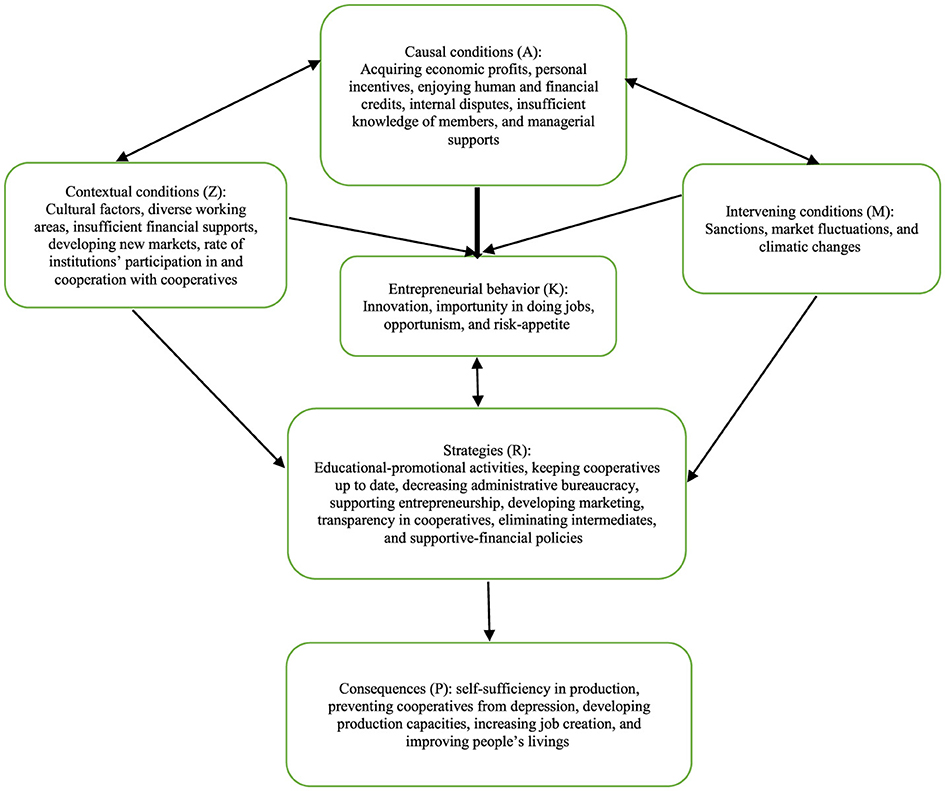
Figure 2. Entrepreneurial behavior development model in agricultural cooperatives of Kermanshah province, based on grounded theory.
3.3 Results of the quantitative section
After developing the final model, the researcher designed a questionnaire according to the obtained model and embarked on finalizing the conceptual model and determining their coefficients using structural equation modeling. To test the research hypotheses, the researcher also employed the structural equation modeling analysis using the Smart-PLA 3 software.
Concerning the needed accuracy for measuring the research constructs, this phase of the study investigated the causal relationships among research constructs.
Figure 3 illustrates the results of the standard coefficients and the significance of the fit structural model.
In the following, Table 7 shows the path analysis of the effect of research structures for model testing.
According to Figure 2, all the factor loadings are confirmed. Also, according to Table 7, all research hypotheses were accepted, which are explained below.
According to Table 7, Causal conditions have direct effects on the constructs of contextual conditions (β = 0.779, p < 0.0001), primary phenomenon (β = 0.164, p < 0.016), and intervening conditions (β = 0.552, p < 0.0001). On the other hand, the causal conditions variable has an indirect positive and significant impact on the primary phenomenon (β = 0.495) through the mediation of two variables, including contextual conditions and intervening conditions. Causal conditions, by themselves, can explain 60.5 and 30.2% of variations in the contextual and intervening conditions, respectively.
Concerning the effects of other variables on the primary phenomenon, we can assert that the variables of causal (β = 0.164, p < 0.016), contextual (β = 0.442, p < 0.0001), and intervening conditions (β = 0.274, p < 0.0001) have direct and significant effects on the primary phenomenon variable. Furthermore, the causal conditions variable (β = 0.495) has an indirect positive and significant effect on the main phenomenon variable. On the whole, these variables can predict 64% of variations in the main phenomenon. Concerning the direct and indirect effects of the variables of the study's conceptual framework on the primary phenomenon variable, we can claim that the significant part of the variability of this variable is explained by the causal conditions variable.
Regarding the direct and indirect effects of the variables of the study's conceptual framework on the strategies variable, we can posit that variables of the primary phenomenon (β = 0.436, p < 0.0001), contextual conditions (β = 0.428, p < 0.0001), and intervening conditions (β = 0.102, p < 0.041) have direct positive and significant effects on the strategies variable. On the other hand, the variables of causal (β = 0.667), contextual (β = 0.193), and intervening conditions (β = 0.119) have indirect positive and significant effects on the strategies variable. In sum, the variables of causal conditions, contextual conditions, the main phenomenon, and intervening conditions (directly and indirectly) can explain 80.1% of variations in the strategies construct. With respect to the direct and indirect effects of the variables of the conceptual framework of the study, we can put that the significant portion of the variation in this variable is explained by the causal conditions variable.
The strategies variable (β = 0.860, p < 0.0001) has a direct positive and significant effect on the consequences variable. Furthermore, the variables of causal conditions (β = 0.582), contextual conditions (β = 0.534), the primary phenomenon (β = 0.375), and intervening conditions (β= 0.190) have indirect positive and significant effects on the consequences variable. These variables can generally explain 73.9% of the variations in consequences. Respecting the direct and indirect effects of the variables of the study's conceptual framework on the consequences variable, we can argue that the significant part of this variation in consequences is explained by the strategies variable.
4 Discussion and conclusion
Concerning the unacceptable economic conditions in Iran, entrepreneurship and cooperatives are discussed as integral financial topics. The managers of various companies and cooperatives should endeavor to develop entrepreneurial behavior by which they can move toward flourishing their systems. The non-compilation of a desirable and comprehensive model for entrepreneurial behavior development in agricultural cooperatives leads to the inefficiency and inactivation of these cooperatives. To this end, the present study attempted to present an entrepreneurial behavior development model in agricultural cooperatives. The difference between the model shown in this research and the existing frameworks in this area is that many of the available models have merely probed the relationships of several particular domains. However, the current study, in addition to focusing on the strategies and consequences, emphasized the factors that impacted entrepreneurial behavior development in agricultural cooperatives; for example, causal, contextual, and intervening factors.
The ultimate fit model of the research shows that the causal conditions that affect entrepreneurial behavior development in agricultural cooperatives include acquiring economic profits, personal incentives, enjoying human and financial credits, internal disputes, the insufficient knowledge of members, and managerial supports. This result is comparable with the findings of Lawrence and Ganguli (2016). Likewise, Kang et al. (2016), Michaelis et al. (2019) and Kotlar and Sieger (2018) highlighted the effect of economic profits on entrepreneurship development.
The intervening conditions involve sanctions, market fluctuations, and climatic changes and, in accompany with contextual conditions like cultural factors, diverse working areas, insufficient financial supports, developing new markets, institutions' rate of participation in and cooperation with cooperatives, and administrative bureaucracy, influence the strategies and development of entrepreneurial behavior. Lawrence and Ganguli (2016) showed that institutions' participation in and cooperation with cooperatives played a chief role in the success of entrepreneurial behaviors. In this respect, we can argue that the cultural component, as a suppressor moderator component, triggers the fade of tendencies to cooperative activities in villages. In particular, disagreements with the working of rural women, who shape half of the rural community, impede the flourishment of the talents of this group of society. Moreover, the lengthy administrative process, delays in examining the projects, and restrictive regulations lead to discouragement and reduced motivation.
The presented strategies encompass educational-promotional activities, keeping cooperatives up to date, decreasing administrative bureaucracy, supporting entrepreneurship, developing marketing, transparency in cooperatives, eliminating intermediates, and supportive-financial policies. These strategies result in the positive consequences of entrepreneurial behavior development in agricultural cooperatives. The consequences are self-sufficiency in production, preventing cooperatives from depression, developing production capacities, increasing job creation, and improving people's livings. Mattihalli (2015), in his study, also showed that reinforcing social participation and taking part in promotional programs were essential factors in fortifying the entrepreneurial behavior development of farmers.
All in all, we can state that all the components that emerged along with the development and manifestation of entrepreneurial behaviors should be considered among agricultural cooperatives. They pave the way for increasing entrepreneurial practices in agricultural cooperatives, improving their conditions, expanding the economy, and, lastly, fully developing villages and the whole country. In this respect, the below suggestions are rendered to planners and policy-makers:
1. Providing interest-free facilities with long-term payoffs as well as suitable economic facilities like secured purchases.
2. Increasing the awareness, skills, and knowledge of cooperative members by observing educational courses.
3. Improving the trading environment of cooperatives and eliminating administrative bureaucracy.
4. Presenting the products of agricultural cooperatives to the stock market and providing free counseling services toward developing new markets.
5. Informing society's women, especially rural women, on establishing cooperatives due to their high sense of commitment, responsibility, sensitivity, and delicacy in doing affairs and possession of social capitals such as participation, trust, etc., compared to men.
5 Limitations
One of the most important limitations of the research is the dispersion of the studied population in both qualitative and quantitative parts, which made the research time-consuming and expensive.
Data availability statement
The raw data supporting the conclusions of this article will be made available by the authors, without undue reservation.
Author contributions
SN: Conceptualization, Data curation, Formal analysis, Funding acquisition, Investigation, Methodology, Project administration, Resources, Software, Supervision, Validation, Visualization, Writing – original draft, Writing – review & editing. KR: Conceptualization, Data curation, Formal analysis, Funding acquisition, Investigation, Methodology, Project administration, Resources, Software, Supervision, Validation, Visualization, Writing – original draft, Writing – review & editing. NN: Conceptualization, Data curation, Formal analysis, Funding acquisition, Investigation, Methodology, Project administration, Resources, Software, Supervision, Validation, Visualization, Writing – original draft, Writing – review & editing.
Funding
The author(s) declare that no financial support was received for the research, authorship, and/or publication of this article.
Conflict of interest
The authors declare that the research was conducted in the absence of any commercial or financial relationships that could be construed as a potential conflict of interest.
Publisher's note
All claims expressed in this article are solely those of the authors and do not necessarily represent those of their affiliated organizations, or those of the publisher, the editors and the reviewers. Any product that may be evaluated in this article, or claim that may be made by its manufacturer, is not guaranteed or endorsed by the publisher.
References
Autio, E., Kenney, M., Mustar, P., Siegel, D., and Wright, M. (2014). Entrepreneurial innovation: the importance of context. Res. Policy 43, 1097–1108. doi: 10.1016/j.respol.2014.01.015
Bird, B., and Schjoedt, L. (2017). “Entrepreneurial behavior: its nature, scope, recent research, and agenda for future research,” in Revisiting the Entrepreneurial Mind. International Studies in Entrepreneurship, eds. M. Brännback, and A. Carsrud (Cham: Springer), 379–409. doi: 10.1007/978-3-319-45544-0_23
Bouichou, E. H., Abdoulaye, T., Allali, K., Bouayad, A., and Fadlaoui, A. (2021). Entrepreneurial intention among rural youth in Moroccan agricultural cooperatives: the future of rural entrepreneurship. Sustainability 13:9247. doi: 10.3390/su13169247
Dam, K. V., Schipper, M., and Runhaar, P. (2010). Developing a competency-based for teacher's entrepreneurial behavior. Teach. Teach. Educ. 26, 965–971. doi: 10.1016/j.tate.2009.10.038
GEM 2015/2016-Global Report (2015). Global Entrepreneurship Monitor. Available at: http://gemconsortium.org/report/49812
General Directorate of Cooperatives Labor, and Social Welfare of Kermanshah Province. (2016). Statistics of General Directorate of Cooperatives, Labor, and Social Welfare of Kermanshah province in 2015. Available on: https://www.mcls.gov.ir
General Directorate of Cooperatives Labor, and Social Welfare of Kermanshah province. (2019). Statistics of General Directorate of Cooperatives, Labor, and Social Welfare of Kermanshah Province in 2019. Available at: https://www.mcls.gov.ir
Giagnocavo, C. L., Bienvenido Bárcena, J. F., Ming, L., Yurong, Z., Sánchez Molina, J. A., and Xinting, Y. (2017). Agricultural cooperatives and the role of organisational models in new intelligent traceability systems and big data analysis. Int. J. Agric. Biol. Eng. 10, 115–125.
Guzmán, C., Santos, F. J., and Barroso, M. D. L. O. (2020). Analysing the links between cooperative principles, entrepreneurial orientation and performance. Small Bus. Econ. 55, 1075–1089. doi: 10.1007/s11187-019-00174-5
Habbershon, T. G., and Pistrui, J. (2002). Enterprising families' domain: family-influenced ownership groups in pursuit of trans generational wealth. Fam. Bus. Rev. 15, 223–237. doi: 10.1111/j.1741-6248.2002.00223.x
Hatton, E. (2015). Work beyond the bounds: a boundary analysis of the fragmentation of work. Work Employ. Soc. 29, 1007–1018. doi: 10.1177/0950017014568141
Herbel, D., Rocchigiani, M., and Ferrier, C. (2015). The role of the social and organizational capital in agricultural co-operatives development practical lessons from the CUMA movement. J. Co-op. Organ. Manag. 3, 24–31. doi: 10.1016/j.jcom.2015.02.003
Kang, J. H, Matusik, J. G., Kim, T. Y., and Phillips, J. (2016). Interactive effects of multiple organizational climates on employee innovative behavior in entrepreneurial firms: a cross-level investigation. J. Bus. Ventur. 31, 628–642. doi: 10.1016/j.jbusvent.2016.08.002
Kellermanns, F. W., Eddleston, K. A., Barnett, T., and Pearson, A. (2008). An exploratory study of family member characteristics and involvement: effects on entrepreneurial behavior in family firms. Fam. Bus. Rev. 21, 1–14. doi: 10.1111/j.1741-6248.2007.00107.x
Kermanshah Province General Directorate of Cooperative Statistics (2023). Statistics of Cooperatives and Members of Cooperatives in 2023. Available at: https://www.mcls.gov.ir
Khosravi, A., Gholamrezaei, S., Rahimian, M., and Akbari, M. (2016). Anayzing obstacles hampering organizational entrepreneurship development in agricultural coopeartives by the use of the grounded theory approach. J. Coop. Agric. 5, 167–189.
Khosravi, E., Naderi, N., Rezaei, B., and Azadi, H. (2021). Investigating the behavioral adaptation model of tourism business owners in Kermanshah Province facing COVID-19 outbreak. Geogr. Environ. Sustain. 11, 55–72. doi: 10.22126/ges.2021.6329.2373
Knudson, W., Wysocki, A., Champagne, J., and Peterson, H. C. (2004). Entrepreneurship and innovation in the agri-food system. Am. J. Agric. Econ. 86, 1330–1336. doi: 10.1111/j.0002-9092.2004.00685.x
Kotlar, J., and Sieger, P. (2018). Bounded rationality and bounded reliability: a study of nonfamily managers' entrepreneurial behavior in family firms. Entrep. Theory Pract. 43, 1–23. doi: 10.1177/1042258718796085
Kuratko, D. F., and Hodgetts, R. M. (2007). Entrepreneurship; Theory, Process, Practice, 7th Edn. Natorp Boulevard Mason; Thomson South Western.
Kuratko, D. F., Ireland, R. D., Covin, J. G., and Hornsby, J. S. (2005). A model of middle-level manager's entrepreneurial behavior. Entrep. Theory Pract. 29, 699–716. doi: 10.1111/j.1540-6520.2005.00104.x
Kurniawan, A., Nurjanana, E., Imang, N., Busari, N., Purwanti, A., Darma, P., et al. (2024). Uncovering the sustainability of agricultural cooperatives in East Kutai, Indonesia. Int. J. Agric. Sci. Res. Technol. Ext. Educ. Syst. 14, 57–74.
Kustepeli, Y., Gulcan, Y., Yercan, M., and Yildirim, B. (2023). The role of agricultural development cooperatives in establishing social capital. Ann. Regional Sci. 70, 681–704. doi: 10.1007/s00168-019-00965-4
Lawrence, C., and Ganguli, D. (2016). Entrepreneurial behavior of dairy farmers in Tamil Nadu. Indian Res. J. Ext. Educ. 12, 66–70.
Liu, Y., Ma, W., Renwick, A., and Fu, X. (2019). The role of agricultural cooperatives in serving as a marketing channel: evidence from low-income regions of Sichuan province in China. Int. Food Agribus. Manage. Rev. 22, 265–282. doi: 10.22434/IFAMR2018.0058
Löffel, U., and Gmür, M. (2024). Entrepreneurial cooperatives: the impact of entrepreneurial orientation on economic and social performance. J. Co-op. Organ. Manag. 12:100234. doi: 10.1016/j.jcom.2024.100234
Ma, W., Renwick, A., Yuan, P., and Ratna, N. (2018). Agricultural cooperative membership and technical efficiency of apple farmers in China: an analysis accounting for selectivity bias. Food Policy 81, 122–132. doi: 10.1016/j.foodpol.2018.10.009
Mattihalli, B. S. (2015). An Analysis of Entrepreneurial Behavior of Maize Seed Producing Farmers of Haveri District (Master of Science Thesis). Bengaluru: University of Agricultural Science.
Michaelis, T. L., Carr, J. C., Scheaf, D. J., and Pollack, J. M. (2019). The frugal entrepreneur: a self-regulatory perspective of resourceful entrepreneurial behavior. J. Bus. Ventur. 35, 1–19. doi: 10.1016/j.jbusvent.2019.105969
Mirakzadeh A. A. Karamian F. Khosravi E. Parvin F. (2021) Analysis of preventive behaviors of rural tourism hosts in the face of COVID-19 pandemic: application of health belief model. Front. Public Health 9:793173. 10.3389/fpubh.2021.793173
Mohammadifar Y. Naderi N. Khosravi E. Karamian F. (2022) Developing a paradigm model for resilience of rural entrepreneurial businesses in dealing with the COVID-19 crisis; application of grounded theory in Western of Iran. Front. Public Health 10:833909. 10.3389/fpubh.2022.833909
Naderi, N., Khosravi, E., Azadi, H., Karamian, F., Viira, A. H., Nadiri, H., et al. (2020). Barriers to developing social entrepreneurship in NGOs: application of grounded theory in Western Iran. J. Soc. Entrep. 13, 221–243. doi: 10.1080/19420676.2020.1765409
Savari, M., Damaneh, H. E., and Damaneh, H. E. (2024a). Managing the effects of drought through the use of risk reduction strategy in the agricultural sector of Iran. Clim. Risk Manag. 45:100619. doi: 10.1016/j.crm.2024.100619
Savari, M., Jafari, A., and Sheheytavi, A. (2024b). The impact of social capital to improve rural households' resilience against flooding: evidence from Iran. Front. Water 6:1393226. doi: 10.3389/frwa.2024.1393226
Savari, M., and Khaleghi, B. (2023). The role of social capital in forest conservation: an approach to deal with deforestation. Sci. Total Environ. 896:165216. doi: 10.1016/j.scitotenv.2023.165216
Shapero, A. (1984). “The entrepreneurial event,” in The Environment for Entrepreneurship, ed. C. A. Kent (Lexington, MA: Lexington Books, D.C. Heath and Company), 21–40.
Shojaei, M., Forouzan, B., and Sharafdin, F. (2011). Cooperatives and obstacles and problems ahead. National conference of entrepreneurship, cooperation, and economic Jihad. Naein: Islamic Azad University-Naein Branch.
Shokati Amghani, M., Mojtahedi, M., and Savari, M. (2023). An economic effect assessment of extension services of agricultural extension model sites for the irrigated wheat production in Iran. Sci. Rep. 13:16947. doi: 10.1038/s41598-023-44290-5
Strauss, A., and Corbin, J. (1998). Basics of Qualitative Research Techniques. London: Sage publications.
Utomo, R. P., Kuleh, Y., and Darma, D. C. (2023). Conventional vs modern: which approach is better for the success of agricultural cooperatives? Agric. Resour. Econ. 9, 26–49. doi: 10.51599/are.2023.09.04.02
XiangyuGuo, M. (2010). Agriculture and agricultural science procedia, study on functions of agriculture cooperative in food safety. Agric. Agric. Sci. Procedia 1, 477–482. doi: 10.1016/j.aaspro.2010.09.060
Zahra, S. A. (2005). Entrepreneurial risk-taking in family firms. Fam. Bus. Rev. 18, 23–40. doi: 10.1111/j.1741-6248.2005.00028.x
Keywords: agricultural cooperatives, cooperation, entrepreneurial behavior, behavior development, mixed-method approach
Citation: Noori S, Roosta K and Naderi N (2024) A mixed-method approach to designing an entrepreneurial behavior development model in agricultural cooperatives of Kermanshah Province. Front. Sustain. Food Syst. 8:1432331. doi: 10.3389/fsufs.2024.1432331
Received: 13 May 2024; Accepted: 21 October 2024;
Published: 06 November 2024.
Edited by:
Antonio Santoro, University of Florence, ItalyReviewed by:
Dio Caisar Darma, Mulawarman University, IndonesiaMoslem Savari, Khuzestan University of Agricultural Sciences and Natural Resources, Iran
Mansour Ghanian, University of Coimbra, Portugal
Copyright © 2024 Noori, Roosta and Naderi. This is an open-access article distributed under the terms of the Creative Commons Attribution License (CC BY). The use, distribution or reproduction in other forums is permitted, provided the original author(s) and the copyright owner(s) are credited and that the original publication in this journal is cited, in accordance with accepted academic practice. No use, distribution or reproduction is permitted which does not comply with these terms.
*Correspondence: Kurosh Roosta, ay5yb29zdGFAaWF1YmlyLmFjLmly
 Saeide Noori
Saeide Noori Kurosh Roosta
Kurosh Roosta Nader Naderi
Nader Naderi